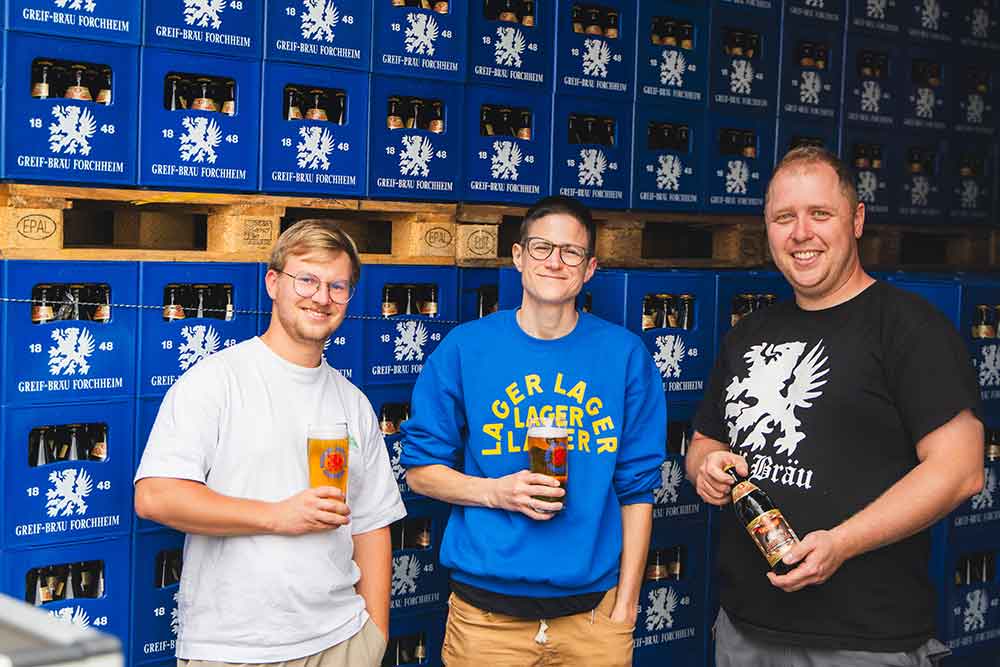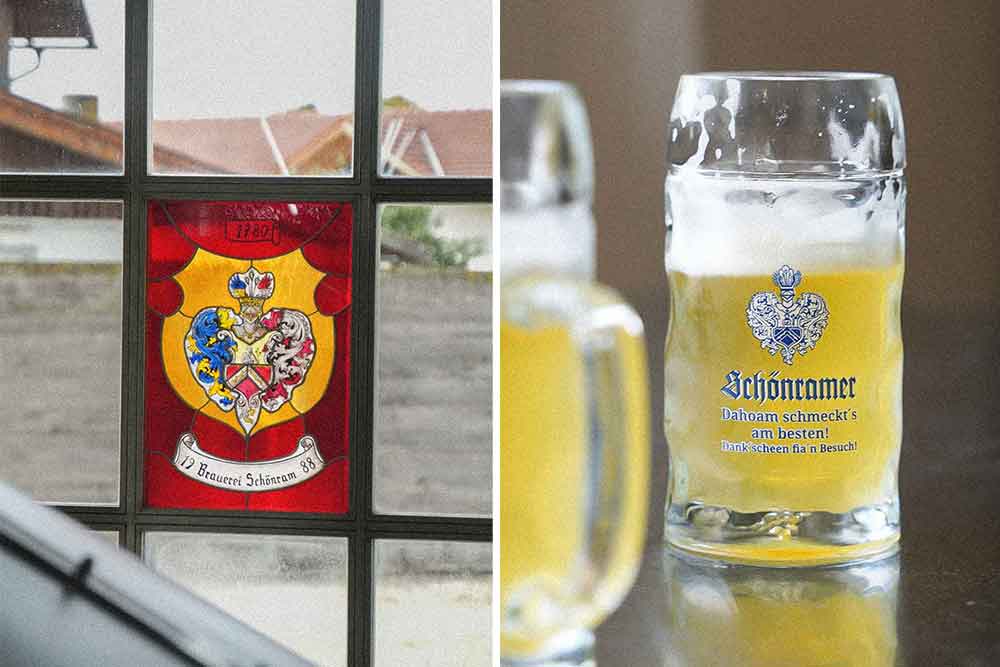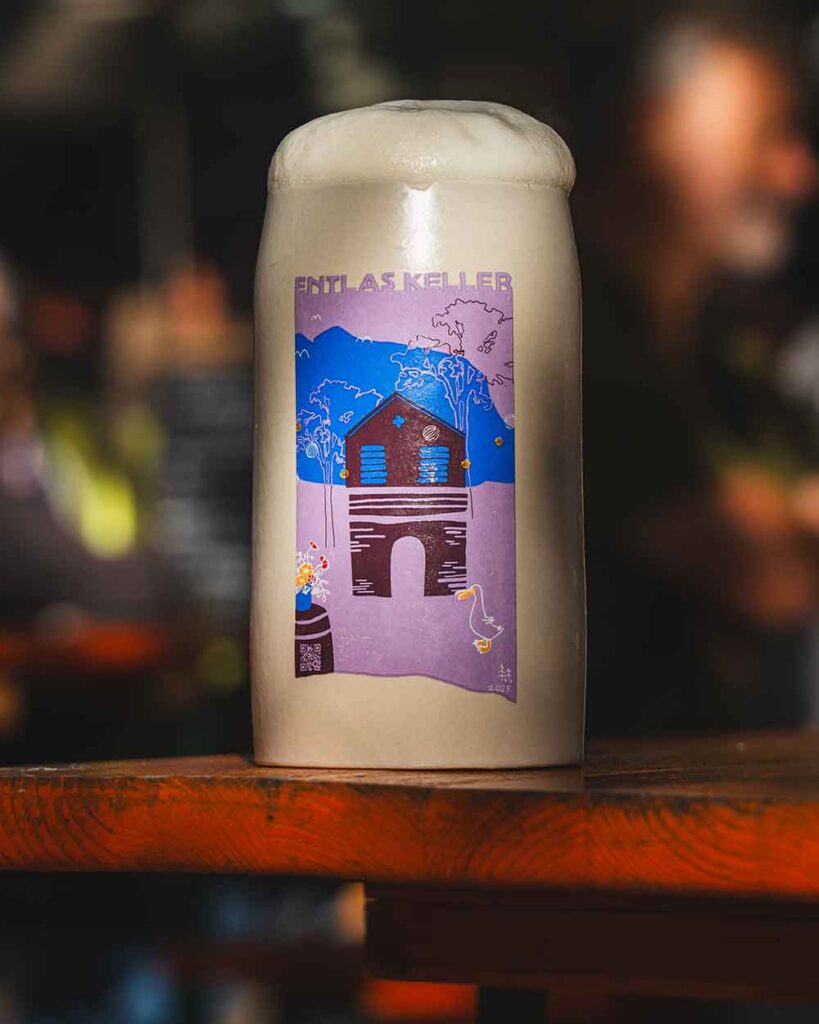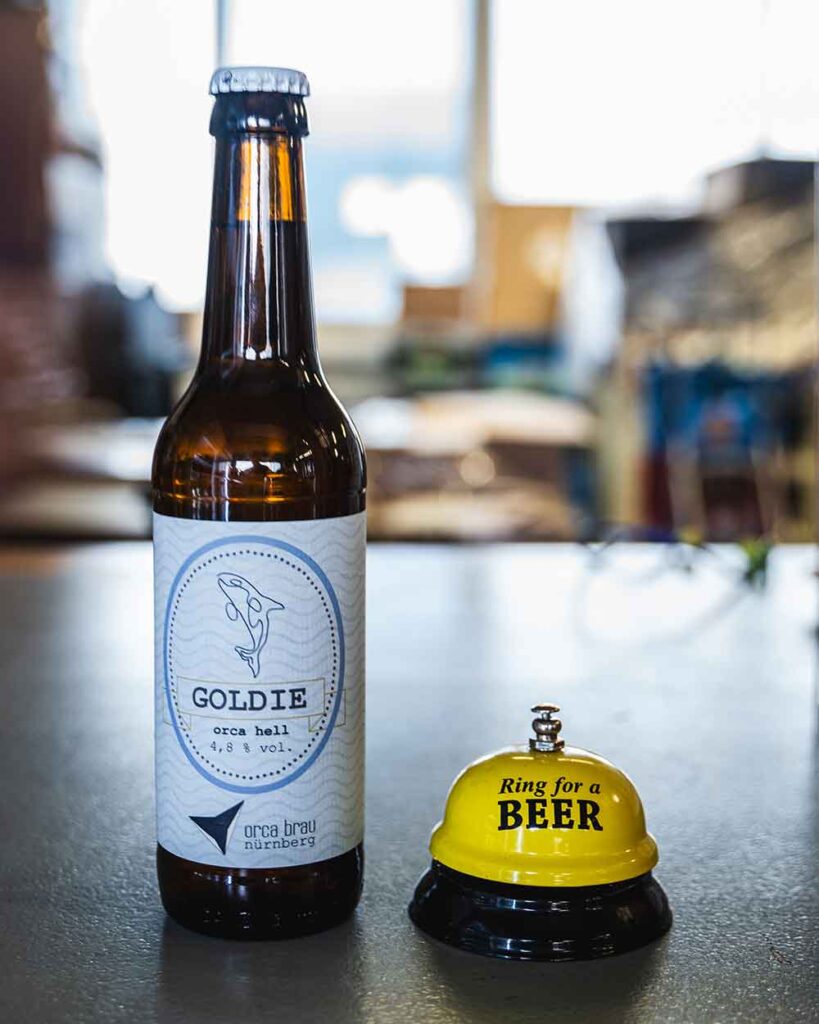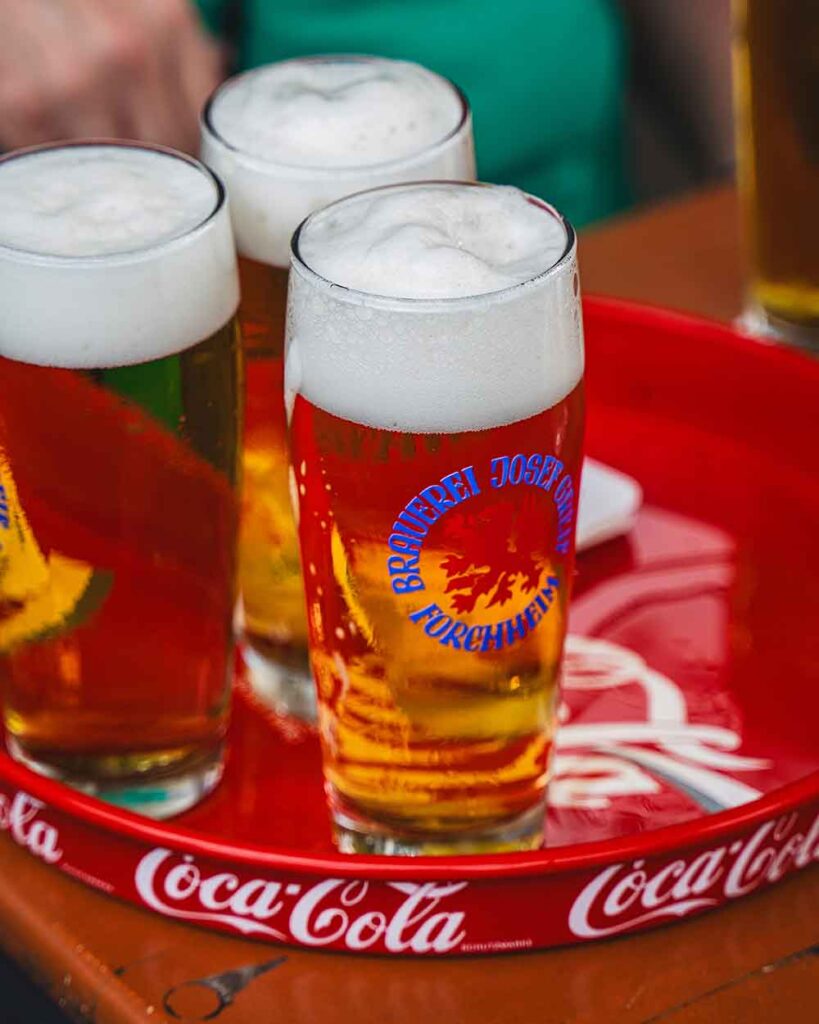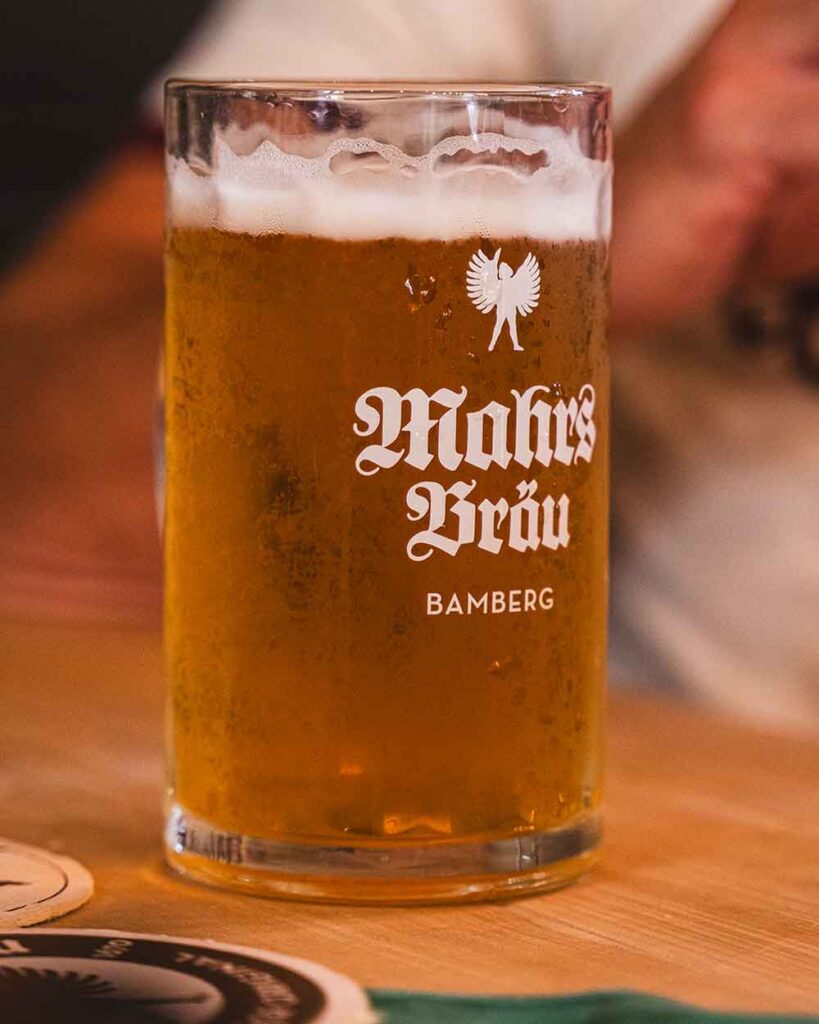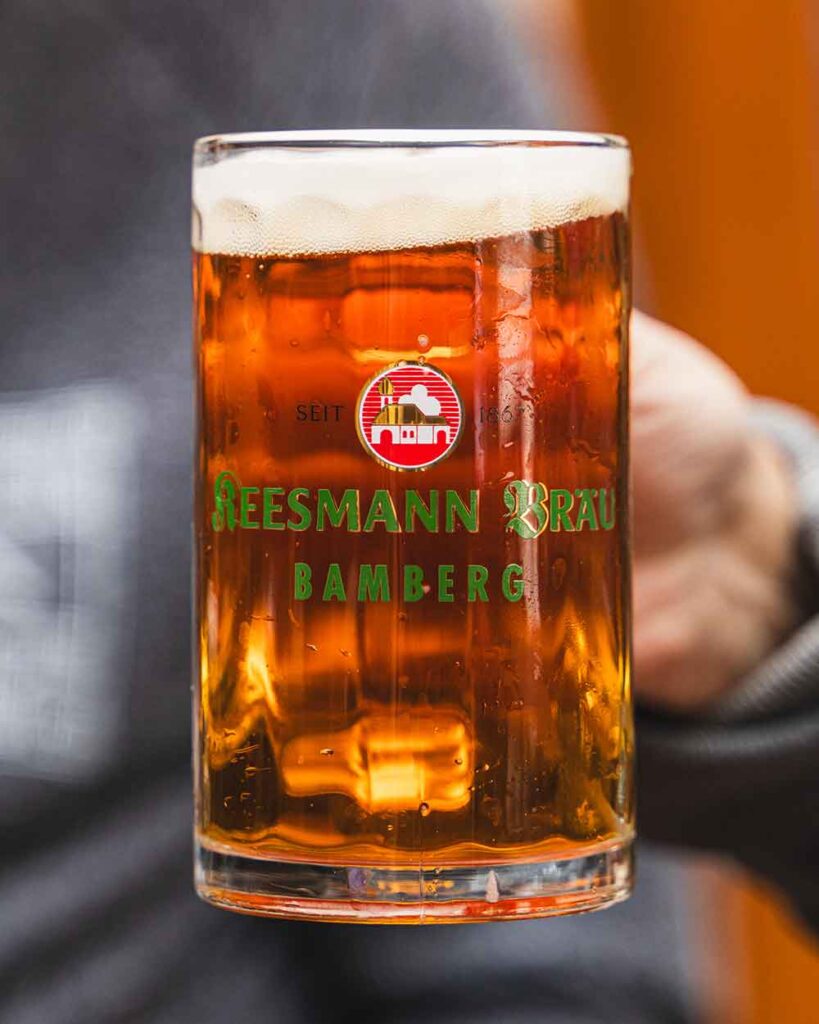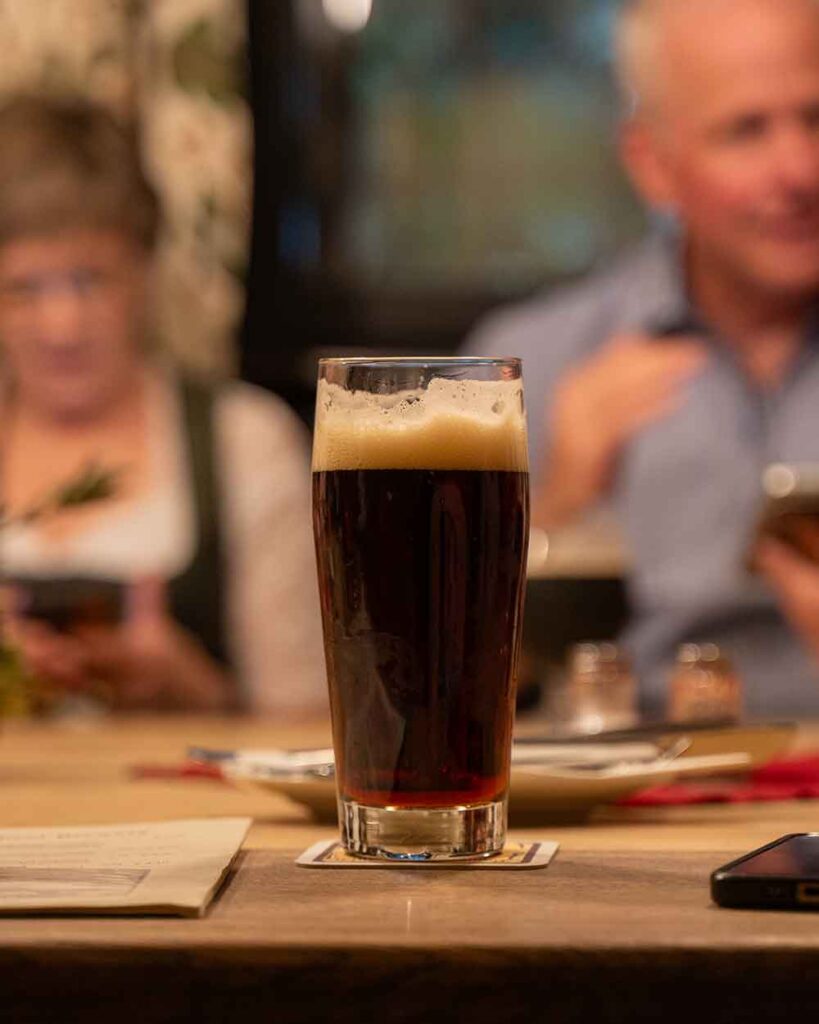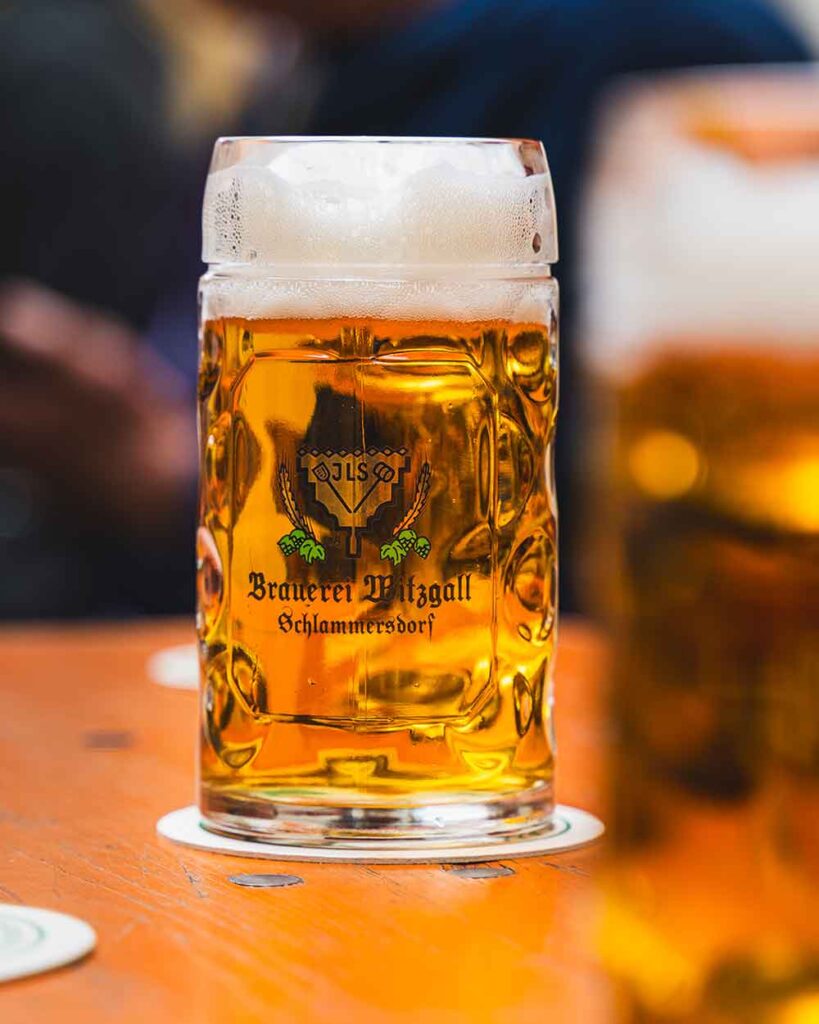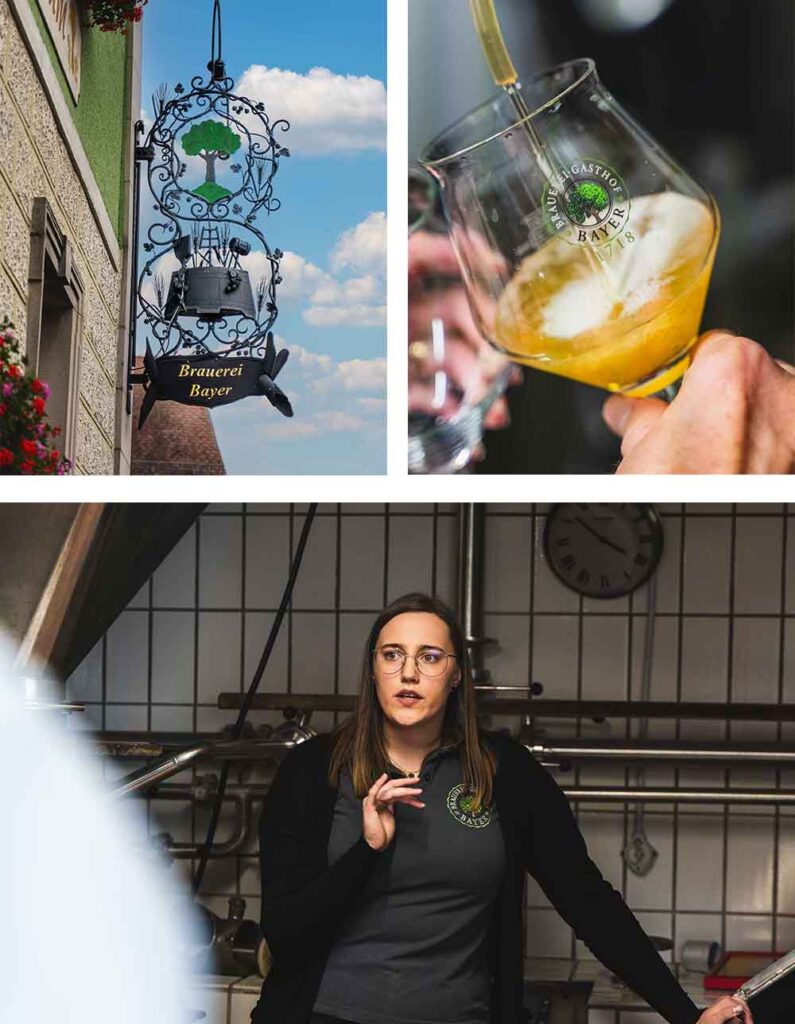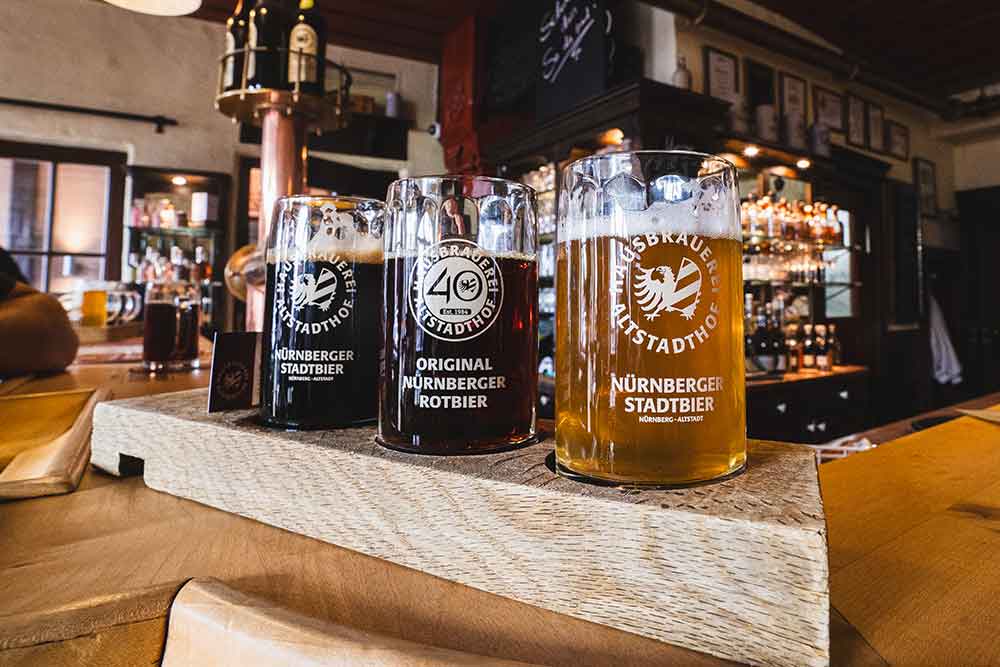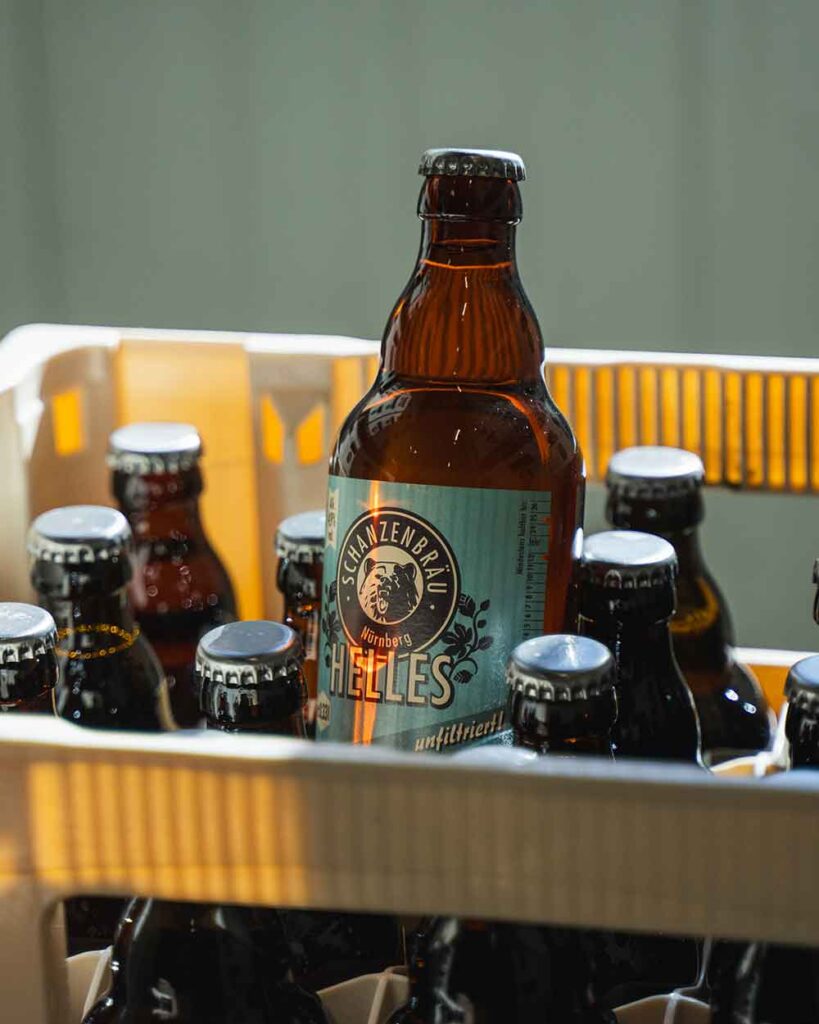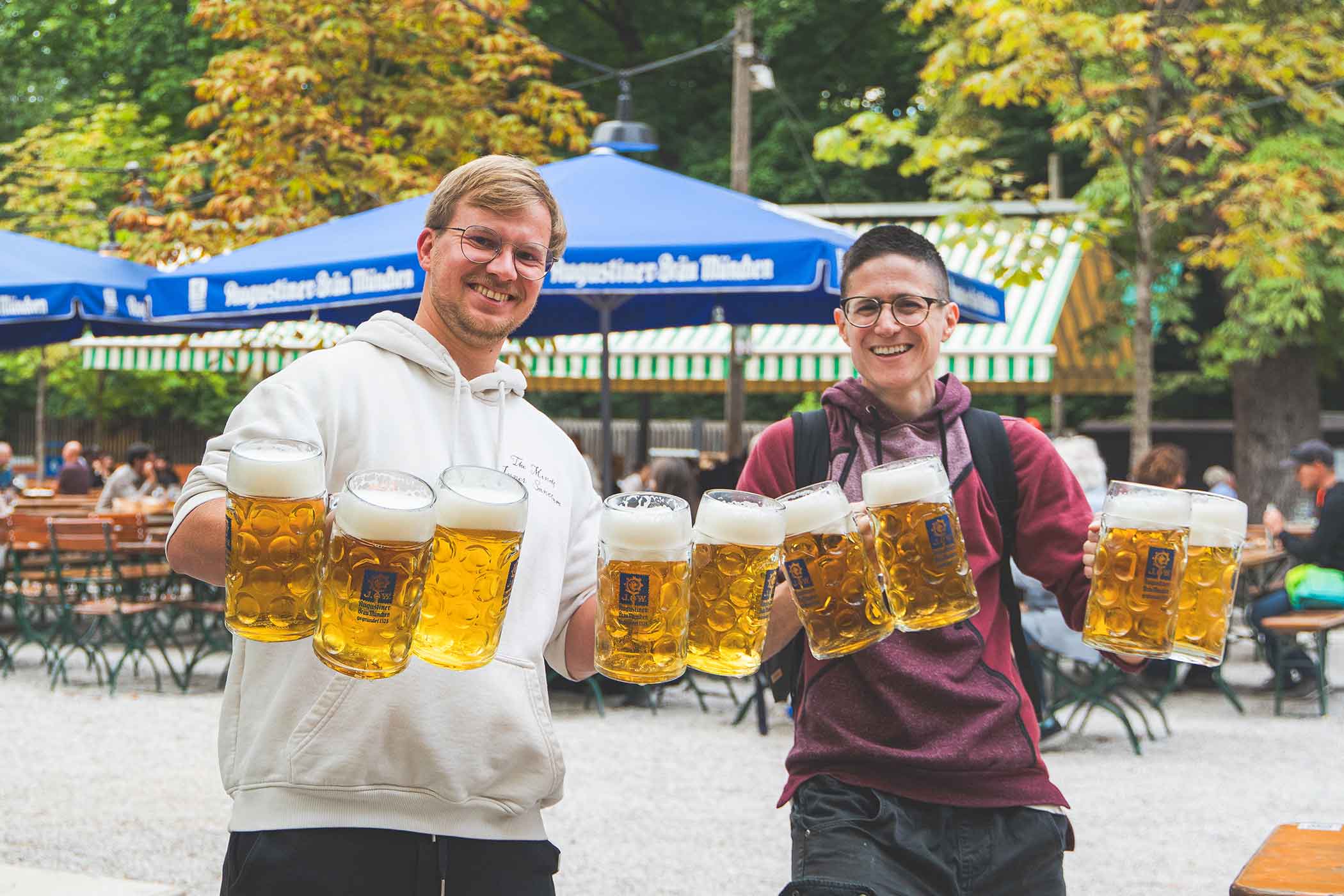Shop
The Top 13 Beers We Drank in October 2025
Lager, lager, lager, lager.
Like This, Read That
October was about one thing and one thing only: Oktoberfest!
Usually, during this time of year, we remind you that you can still celebrate this amazing autumnal holiday, even if you can’t get across the pond. And that’s all true.
But this year, we finally did it. We bit the burger (bad German beer joke?), and teamed up with Trip’s Beer Trip to run our very first epic bier adventure overseas.
Our goal? To experience Germany’s beer culture the way locals do—slowly, joyfully, and with an empty stomach (and soul) ready to be filled. Whether it was raising a maß (pronounced mas, this is the German word for a one-liter beer mug) of golden Helles beneath leafy trees at Augustiner-Keller, discovering the underworld of Entla’s Keller in Erlangen, or learning the difference between rotbier and rauchbier firsthand, each stop offered something more than just a pint: We found a story.
Whether it was in Schlenkerla’s storied, smoky halls.
Or at one of Germany’s coolest craft breweries, Orca Brau.
We spent a whole week exploring the drinking nooks and crannies of Bavaria and Franconia, ending at our very first official Oktoberfest!
So here’s to a month where we finally got off our couches, onto a plane, and made it to Germany during arguably the best time of year to be drinking beer.
Interested in hearing when we curate our next trip? Sign up here to get updates first.
Hop Culture’s Top 13 Beers We Drank in October 2025
Schönramer Hell – Private Landbrauerei Schönram
Petting, Bayern, Germany
Helles – Let’s be honest: We drank a lot of lager during our time in Germany, from helles to kellerbiers and zwickelbiers to landbiers and vollbiers and everything in between.
After lapping in the lager luxury for a week, Schönramer Hell still stands at the top of our charts for favorite beers we drank on the trip.
There are a few things Schönram does to make this beer stand out.
While Schönram Deputy Brewmaster and Head of Quality Assurance Tobias Kohrs can’t tell you precisely what hops go into this beer, or “as our first brewmaster used always to say, I could tell you, but I’ll have to kill you,” he could share that they’re all typical traditional German hops from either Hallertau or Tettnang. Do with that what you will.
Schönram Senior Brewmaster Eric Toft, whose care and devotion for sourcing the right raw ingredients in Schönram’s beers is unparalleled, expands a little further, noting they only use aroma varieties from four hop farms, with three hop additions at fifty, thirty, and fifteen minutes.
The result is a helles that’s slightly hoppier than others in the area, but “the drinkability is there,” says Kohrs. “It’s not sweet in the mouth, and combined with the bitterness, you still have the thirst to drink another one.”
A blend of slightly under modified winter and summer barleys provides the base for the helles, which goes through a single decoction to coax out a little more character and flavor.
Schönram also openly ferments its lagers, hand-skimming resins off the top throughout fermentation. They believe this process removes unwanted compounds from the beer, focusing solely on the bitterness they want. This isn’t by any means a new practice in the region, but Toft says they are one of just a handful of breweries still doing it. In fact, Schönram’s newest cellar is a bespoke design, combining five large 450-hectoliter open-fermentation vessels with an automatic cleaning system.
The helles then spends between thirty-eight to forty-nine days lagering in horizontal tanks, which is what Toft calls the “sweet spot” for Schönram’s best-selling beer.
“It makes a huge difference to have proper maturation,” explains Toft, who says his obsessive compulsive tendencies to tweak things when it comes to brewing have benefited the helles.
“I’m actually never happy,” Toft says with a small smile. “If I think my beer is perfect, then I have a problem. I should probably stop because…you should always be thinking about a way to make it better.”
Well, we think Schönram’s helles is pretty perfect.
Lagerbier Hell – Augustiner-Bräu München
Munich, Bayern, Germany
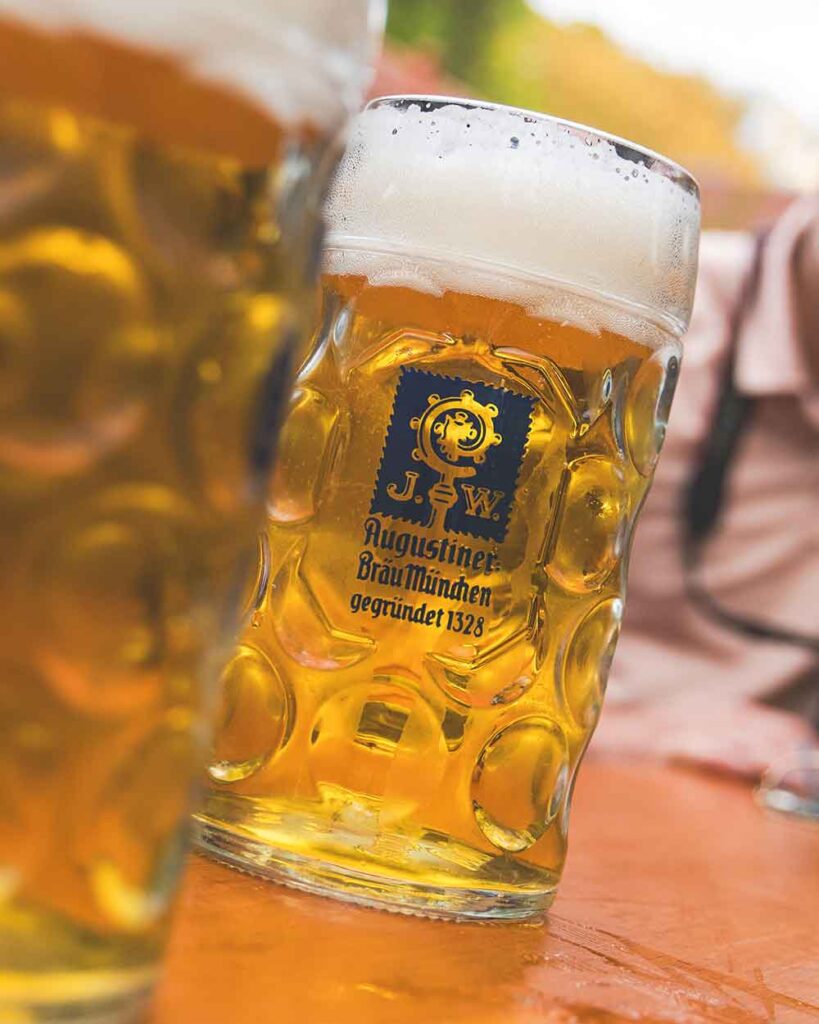
Photography courtesy of Magic Muncie, Social Media Manager, Hop Culture and Untappd
Helles – Don’t mess with perfection. “Pretty much the best beer in the world, in my humble opinion, is Augustiner Lagerbier Hell,” Wondrous Founder Wynn Wisenhunt once told us. “In Munich, it’s the people’s beer.”
After our most recent visit to Bavaria and Franconia with Trip’s Beer Trips, we finally understand what Wisenhunt means.
Interested in hearing when we curate our next trip? Sign up here to get updates first.
“It’s juicy water,” he explained to us, throwing out more descriptors. “It’s super light and refreshing but has this velvety, almost jelly-like body where it’s not grainy, it’s not sweet, but it has this fullness to it, but it’s still dry and crisp.”
He adds, “It’s one of the wildest beers I’ve ever had.”
While we can’t say it’s one of the “wildest” beers we’ve ever had, we can say it’s one of the most delicious.
Cold, crisp, clear, and slightly malty, you can easily find yourself downing a one-liter stein of this luscious liquid, especially while sitting under the leafy canopy of Augustiner Keller’s beautiful beer garden.
Kellerbier Brudi – Entla’s Keller
Erlangen, Bayern, Germany
Kellerbier/Zwickelbier – Entla’s Keller is a special place—“the heart and soul of Erlangen,” according to Matze Havel, who showed us around the twenty-one kilometers of tunnels dug to store beer through the Erlanger Burgberg (which translates to Castle Mountain in English).
Heart, soul, and lots of sweat go into everything at Entla’s Keller: that and a little ingenuity. Oval shafts bored into the hill, carved specifically by hand with picks and hammers in the most stable shape: an egg.
Slightly chilly, the keller stays at a cool, constant eight degrees Celsius (about forty-six degrees Fahrenheit). “It doesn’t matter if it’s summer or winter,” says Havel. “The whole year long, the mountain gives us eight degrees.”
Since 2021, the natural beer cellar has also brewed beer, installing a fully automated, emission-free fifteen-hectoliter brewhouse literally into the mountain!
The decision has made Entla’s Keller very unique.
“In Europe for sure and maybe worldwide, we are the only brewery that is fully brewing, storing, and fermenting beer in a mountain,” shares Havel, who considers himself a cellar nerd, even getting married in one of the cellar’s tunnels—what he calls the “heart chamber of the hill.” “So what you drink maybe later on, it’s the only real cellar beer you can have on Earth.”
We had a chance to try some of those beers, including Kellerbier Brudi, a nice, clear, slightly malty lager, brewed with a sense of place.
Pro Tip: Grab a fresh pretzel; they’re made slightly differently in Erlangen without the use of lye, so you get a slightly paler, but very crispy, exterior with a fluffy interior. Sit out in the beautiful beer garden, pretzel in one hand, stein of cellar-brewed kellerbier in the other, and just never leave. We almost didn’t. To us, this is why, as a beer drinker, you travel to Germany.
Goldie – Orca Brau
Nuremberg, Bayern Germany
Blonde/Golden Ale – A craft brewery in Nuremberg, Orca Brau considered itself a North American-style brewery, according to co-founder Felix vom Endt, who spent one year living and working in Vancouver, BC, Canada.
The brewery focuses on three types of beer: traditional German lagers, modern contemporary hoppy ales, and experimental styles (hello, raspberry chili smoked porter!).
While Orca Brau’s pale ale, called wanderlust, is a best seller, we actually fell in love with Goldie.
The part-blonde-ale-part-helles-lager includes a blend of traditional barley and a historic Franconian malt revived from near extinction.
“It has its own character—it’s a little bit more caramel, honey,” explains vom Endt, who says this means it’s actually a much harder Pilsner malt to brew with because you have to pay more for it and boil it longer. “But at the end, you have a super interesting and complex product … that makes the beer more interesting to drink.”
And in Franconia, the land of incredible lagers, setting yourself apart is key.
If you need a true testament to the quality of this beer, our guide on the trip, Tobias Kerschbaumer, who lives in Nuremberg, had this to say about Goldie: “I drank this and it was perfect!”
Enough said.
Hell – Brauerei Josef Greif
Forchheim, Bayern, Germany
Helles – A sort of old-school tavern, Greif Keller had one of our favorite helles right from the barrel.
“So, guys, something about the beers,” Kerschbaumer told us as they began filling our glasses. “You see all the awards they’ve won. They’re World Beer Award winners two years in a row.” Most recently for their Annafestbier, brewed only for the Franconian festival held in late July and early August.
Pouring a clear, almost smudgy gold, Greif Hell had a decent minerality to it, like rocks from a stream, with a bit of maltiness in the background.
aU Ungespundet Naturtrüb – Mahrs Bräu
Bamberg, Bayern, Germany
Kellerbier/Zwickelbier – We learned about Mahrs Bräu after repeated appearances during the Firestone Walker Invitational. So, when we planned the Untappd Epic German Bier Experience, we knew that this Bamberg-based brewery had to be a must-stop.
When you visit, you’ll find a lot of half-liter steins full of the brewery’s kellerbier, called aU Ungespundent Naturtrüb.
Ungespundet means unbunged, referring to a traditional German practice where you leave the barrel loosely covered to allow excess carbon dioxide to blow off, resulting in a beer with lower carbonation.
The “U” could also stand for unfiltered. A little cloudy, this kellerbier also uses Hallertauer Perle hops for a slightly complementary hoppy bite.
Although this kellerbier is no longer served by gravity, the beer still drinks deliciously, with a decent maltiness reminiscent of Honey Nut Cheerios and just a hint of lemon verbena in the finish.
Sternla Lager – Keesman Bräu
Bamberg, Bayern, Germany
Amber Lager – Within spitting distance of Mahrs Bräu, Keesman Bräu produces the Bamberger Herren Pils, which Hop Culture freelance writer Ryan Pachmayer thinks many visitors should add to their shortlist, thanks to its “striking bitterness but a rounded malt flavor underneath to balance.”
We actually tried the Sternla Lager, an amber lager that had a touch of a torched marshmallow flavor and caramel roast. Nice, rich, and crispy, this amber reminded me a bit of a Samoa Girl Scout cookie with a chewy note of caramel and chocolate.
When you have two wunderkind breweries kitty-corner from each other, you could spend the whole afternoon on this one street.
Aecht Schlenkerla Rauchbier – Märzen – Schlenkerla (“Heller-Bräu” Trum)
Bamberg, Bayern, Germany
Rauchbier – Just look for the streetlight. Down one of Bamberg’s cobblestone streets, underneath the streetlight, you’ll find one of the most quintessential smoked beer breweries in the world—Schlenkerla.
On a cold fall night in September, we tramped through the quaint alleys of Bamberg, down a small side street, to bow our heads under the iconic Schlenkerla lamp that stands resolute outside the tavern, welcoming weary travelers inside to whet their whistle.
When we visited, the pub was packed wall to wall, with people spilling out into the street, holding pints of dark beer snugly in their hands—Aecht Schlenkerla Rauchbier.
Our guide, Kerschbaumer, provided us with valuable advice on how to drink this beer.
“Savor it,” he told us. “You won’t find a beer like this anywhere else in the world.”
Sixth-generation Schlenkerla Brewmaster Matthias Trum tells it to us in a different way. “There’s an old Bamberg proverb that when you drink smoked beer,” he says, “you have to drink three pints to fully appreciate the aroma and flavor.”
Taking a sip of this distinctly smoky, umami beer made the constant hubbub in the tavern’s main dining room melt away. Truly a best-beer-drinking moment, we savored this pint.
To be honest, we only need one pint to fall in love with this beer.
Spezial Rauchbier Märzen – Brauerei Spezial
Bamberg, Bayern, Germany
Rauchbier – For research purposes, when in Bamberg, we highly recommend trying both Schlenkerla and Spezial’s smoked beers.
Definitely more of a local spot, Spezial Keller is like a smoked beer refuge, a safe port away from the storm of the city.
The smoked beer itself is also more muted than Schlenkerla’s, as our waiter explained to us.
Definitely more mild, Spezial Rauchbier Märzen still had a pleasant smoky backbone, but it was more like pipe smoke instead of cigar smoke, if you get our drift.
Instead of drinking straight-up bacon, it was like sipping a beer while bacon is cooking somewhere inside the house. You get a pleasant hug from the smokiness instead of a punch in the face.
Whether one is better than the other probably depends on your preferred level of smokiness in a beer.
Vollbier – Brauerei Witzgall
Hallerndorf, Bayern, Germany
Helles – Visiting Brauerei Witzgall came highly recommended from Frank Trosset, the former co-founder of Aslan Brewing in Bellingham, Washington, who had lived in Franconia for almost a year while working at a sixth-generation family-run brewery in a tiny village of two hundred people.
Trosset suggested we try the Vollbier, a sort of fuller, rustic lager that’s only available on draft. While Brauerei Witzgall’s landbier (only available in bottles) is more highly rated (the highest-ranked landbier on Untappd for the last two years), the Vollbier, according to brewmaster Matthias Witzgall, sells better.
We can see why. The Vollbier is absolutely phenomenal, pouring a crystal-clear gold with more body and taste than a helles. The rustic lager had a distinct hop presence, with a hint of Noble hop slickness and spiciness that complemented the fuller, malty body. We might call this more like the West Coast IPAs of rustic land lagers, if we can be so bold.
Drink a half-liter of that while sitting in Brauerei Witzgall’s little alley beer garden underneath a one-hundred-year-old pear tree that Matthias used to climb as a kid, and we guarantee life gets better for a little while.
Ungespundetes Landbier – Brauerei-Gasthof zum Grünen Baum Bayer Theinheim
Theinheim, Bayern, Germany
Landbier – For one of our favorite landbiers of the entire trip, head to Brauerei-Gasthof “Zum Grünen Baum” Bayer Theinheim (aka Brauerei Bayer), a thirty-minute drive, an hour and a half train ride, or an hour-and-forty-five-minute bike ride west of Bamberg.
Helmed by master brewer Stefanie Bayer, Brauerei Bayer is one of the smallest breweries in Franconia, a region in northern Bavaria that boasts its own distinct culture, cuisine, dialect, and even beer styles (hence: landbier and vollbier). Consider that Franconia is to Bavaria as Scotland is to the U.K., a distinct place with its own identity within a larger amalgamated region.
And the family-run brewery, owned by the Bayers since 1718, proudly keeps things local, sourcing pilsner and Munich malt from Bamberg and hops from Hallertau and Spalt.
Brewing runs in Stefanie’s blood. Her grandad was the last brewmaster, while her uncle also brews, and her dad, Michael Bayer, owns the brewery but helms the kitchen. Since she was five years old, Stefanie has helped out in the restaurant and brewery, cleaning glasses and tapping kegs. When she grew up, Stefanie eventually earned her bachelor’s in brewing at Doemens Academy in Munich, taking over the reins.
The small 40-hectoliter brewery makes about 2,500 to 3,000 hectoliters a year, focusing mainly on just two types of beer—landbier and knörzla, a sort of rustic amber lager whose name roughly translates to a couple of things like “from the woods” or the Franconian word for the end of the bread. Which, with a malt bill of Pilsner, Munich, and caramel malt, is pretty much what this beer tastes like.
Somewhat coincidentally, while we visited, Hop Culture Social Media Manager Magic Muncie struck up a conversation with a guy wearing an Other Half tee at the table next to ours.
Turns out Pachmayer had actually interviewed Jose Santos Caro for his own piece on “Everything You Need to Know About Visiting Franconia’s Rich Beer Scene.”
Santos Caro, who estimates he’s visited 300 of the 350 breweries in Franconia, considers Brauerie Bayer in his top ten. He counts himself a regular here and couldn’t have been more stoked that we were visiting. He thinks the Landbier is top-notch here, giving it effusive praise throughout our conversation.
Absolutely delicious, we crushed three or four of these ourselves from their beautiful mugs, making us feel like regulars, even if just for a few hours. Zippy with a whisper of underlying spiciness, the 4.7% ABV beer presented mostly clean malt, with nothing over the top.
“It’s very, very easy to drink,” Stefanie almost cautioned us.
To truly understand what landbier can be, you must try Brauerei Bayer’s version.
Nürnberger RotBier – Hausbrauerei Altstadthof
Nürnberg, Bayern, Germany
Rotbier – “As this is Nürnberg, they are known for their red beer,” Kerschbaumer told us as we all sat around the bar at Hausbrauerei Altstadthof while the bartender expertly filled small steins with a ruby red liquid.
She poured with precision, opening up the tap to fill the mug little by little, “building up the foam so that you have a thick foam that lasts longer than two to four seconds,” explained Kerschbaumer. “This is how we pour beer here.”
The strikingly beautiful lager known as Rotbier is endemic to Nürnberg.
“And it’s not pronounced root beer,” Kerschbaumer cautions us. It’s more like wrote beer.
The rustic Franconian lager should have a low Noble hop bitterness, accompanied by a predominantly medium toasted malt sweetness.
A distinctly jeweled garnet red, Alstadthof’s Nürnberger Rotbier smelled like sweet cherry. Almost a little roasty, with a hint of warm chestnut, this rotbier finished with an almost browned, buttery nuttiness. Dry in the back, like raspberry jam on multigrain toast, this amber lager lit up the room.
Helles – Brauerei Schanzenbräu
Nürnberg, Bayern, Germany
Helles – Drinkability is the keyword at Schanzenbräu, whose red lager, for example, at twenty-six IBUs, is actually one degree above where Brauerei Schanzenbräu Founder Stefan Stretz likes his beers to be. “Twenty-five is usually our maximum,” he admits. “We like the drinkability of beers.”
The Helles, on the other hand, hits that sweet spot at twenty-four IBUs.
Stretz is incredibly proud of his helles. “It’s not that easy to produce a helles,” he explains. “You can’t make any mistakes. … You can’t hide behind anything.”
After enjoying a full glass and a taster off the tanks, we can confirm that Schanzenbräu’s helles was one of our favorites of the trip. Grainy, but not overly sweet, the lager had layers of flavor. Almost like a super light version of Honey Nut Cheerios, a bowl of which you enjoy from the first spoonful to the last slurp of that malty milk.
Born and raised in Nürnberg, Stretz trained to be an engineer but followed his passion for brewing to open Schanzenbräu in 2004, in the basement of a car repair shop.
Now the largest private brewery in Nürnberg, Schanzenbräu has become a pioneer of beer culture in the city.
You can taste the passion and heart of this place in each of Stretz’s beers.
“Honestly,” says Kerschbaumer, “I recommend everything here.”
But if we had to pick one to start: make it the Helles!

